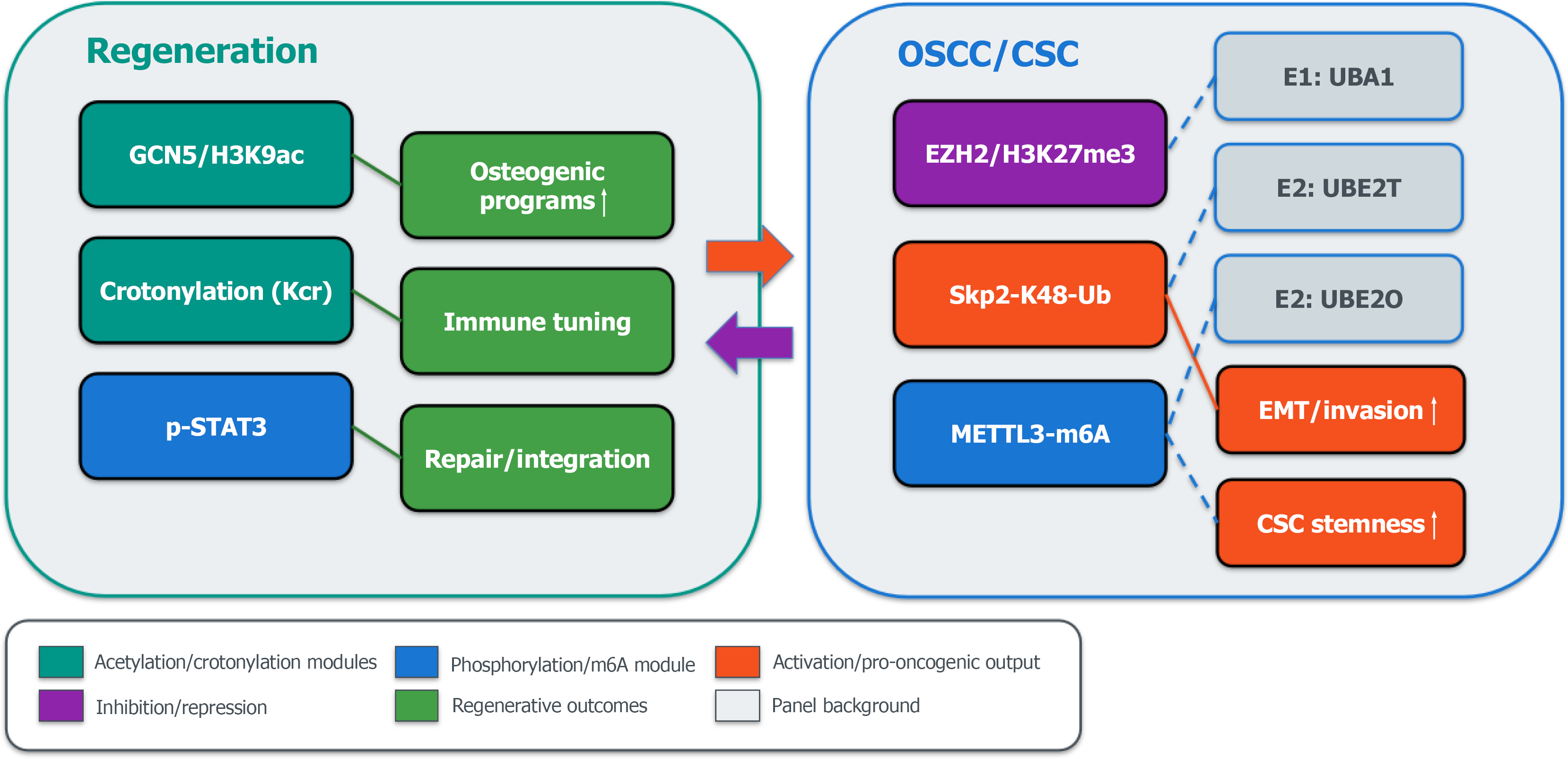Copyright
©The Author(s) 2025.
World J Stem Cells. Nov 26, 2025; 17(11): 112702
Published online Nov 26, 2025. doi: 10.4252/wjsc.v17.i11.112702
Published online Nov 26, 2025. doi: 10.4252/wjsc.v17.i11.112702
Figure 1 Post-translational modification classes and their associated pathways shaping dental-derived mesenchymal stem cell outcomes in periodontal regeneration vs oral squamous cell carcinoma/cancer stem cell.
Regeneration: Acetylation/crotonylation, phosphorylation, trimethylation, ubiquitination, and N6-methyladenosine act on representative pathways including Wnt/β-catenin, bone morphogenetic protein/SMAD1/5/8, mitogen-activated protein kinase (p38/c-Jun N-terminal kinase) → runt-related transcription factor 2, Notch/Hedgehog, signal transducer and activator of transcription 3 (pro-repair), and nuclear factor-kappa B (resolution) to bias lineage commitment and tissue integration. Oral squamous cell carcinoma/cancer stem cell: Post-translational modification (PTM)-driven rewiring converges on Janus kinase/signal transducer and activator of transcription 3, phosphatidylinositol 3-kinase/protein kinase B/mammalian target of the rapamycin, transforming growth factor-β/SMAD2/3 → epithelial-mesenchymal transition, Hippo/YAP-TAZ, nuclear factor-kappa B, and β-catenin activation, promoting plasticity, immune evasion, and therapy resistance. Straight connectors indicate regulatory influence (not arrows); colored groupings label PTM classes; listed pathways are representative rather than exhaustive. This schematic complements the main text by summarizing how PTM categories interface with core signaling networks under regenerative vs malignant contexts. GCN5: General control non-depressible 5; H3K9ac: Histone H3 lysine-9 acetylation; Kcr: Lysine crotonylation; STAT3: Signal transducer and activator of transcription 3; OSCC: Oral squamous cell carcinoma; CSC: Cancer stem cell; EZH2: Enhancer of zeste homolog 2; H3K27me3: Histone H3 lysine-27 trimethylation; Skp2: S-phase kinase-associated protein 2; K48: Lysine-48-linked polyubiquitin; Ub: Ubiquitin; METTL3: Methyltransferase-like 3; m6A: N6-methyladenosine; UBA1: Ubiquitin-activating enzyme E1; UBE2T/UBE2O: E2 ubiquitin-conjugating enzymes; EMT: Epithelial-mesenchymal transition; E1/E2/E3: Ubiquitin-activating/-conjugating/-ligase enzymes.
Figure 2 Sequential post-translational modification cascade driving the shift from regeneration to malignancy in dental-derived mesenchymal stem cells.
A vertical timeline (centre) depicts six key post-translational modifications (PTMs) that accumulate in a fixed order: General control non-depressible 5-mediated histone-H3 lysine-9 acetylation, lysine crotonylation, signal transducer and activator of transcription 3 tyrosine-705 phosphorylation, enhancer of zeste homolog 2-catalysed histone-H3 lysine-27 trimethylation, S-phase kinase-associated protein 2-directed K48-linked ubiquitination, and methyltransferase-like 3-dependent N6-methyladenosine RNA methylation. Left-hand annotations summarize regenerative outcomes of each modification (e.g., osteogenic switch-on, extracellular-matrix mineral build-up), whereas right-hand annotations indicate the corresponding cancer stem cell or malignant traits that emerge as the same PTMs intensify (e.g., invasion programme silent → epithelial-mesenchymal transition onset, polycomb repression of bone genes, immune-escape programme locked). The downward arrow signifies temporal progression: Early, reversible PTMs support tissue repair; late, irreversible PTMs consolidate oral squamous cell carcinoma cancer stem cell phenotypes. CSC: Cancer stem cell; GCN5: General control non-depressible 5; H3K9ac: Histone H3 lysine-9 acetylation; ECM: Extracellular matrix; STAT3: Signal transducer and activator of transcription 3; EMT: Epithelial-mesenchymal transition; EZH2: Enhancer of zeste homolog 2; H3K27me3: Histone H3 lysine-27 trimethylation; Skp2: S-phase kinase-associated protein 2; METTL3: Methyltransferase-like 3; m6A: N6-methyladenosine.
- Citation: Liu W, Yang YY, Shi ZJ. Post-translational modifications in the oral microenvironment: Stem cell regulation from periodontal regeneration to oral cancer therapy. World J Stem Cells 2025; 17(11): 112702
- URL: https://www.wjgnet.com/1948-0210/full/v17/i11/112702.htm
- DOI: https://dx.doi.org/10.4252/wjsc.v17.i11.112702














